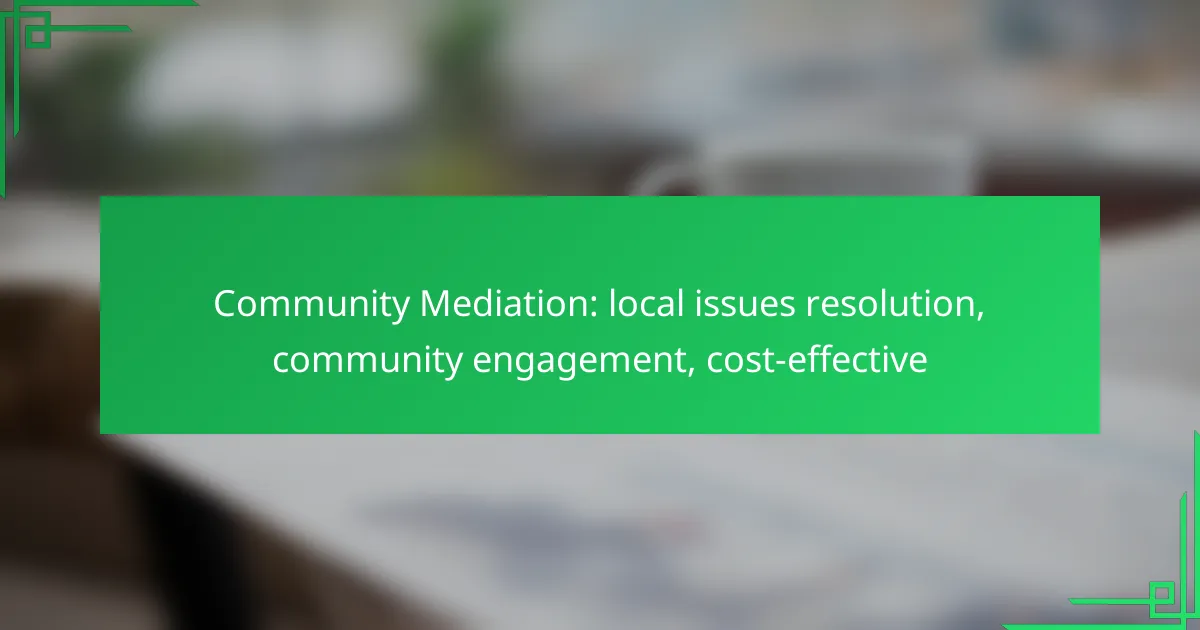Community mediation serves as an effective tool for resolving local disputes by promoting open dialogue between conflicting parties. This structured process not only leads to mutually beneficial agreements but also strengthens community ties and encourages active engagement among residents. As a cost-effective alternative to traditional legal avenues, community mediation fosters understanding and harmony within neighborhoods.
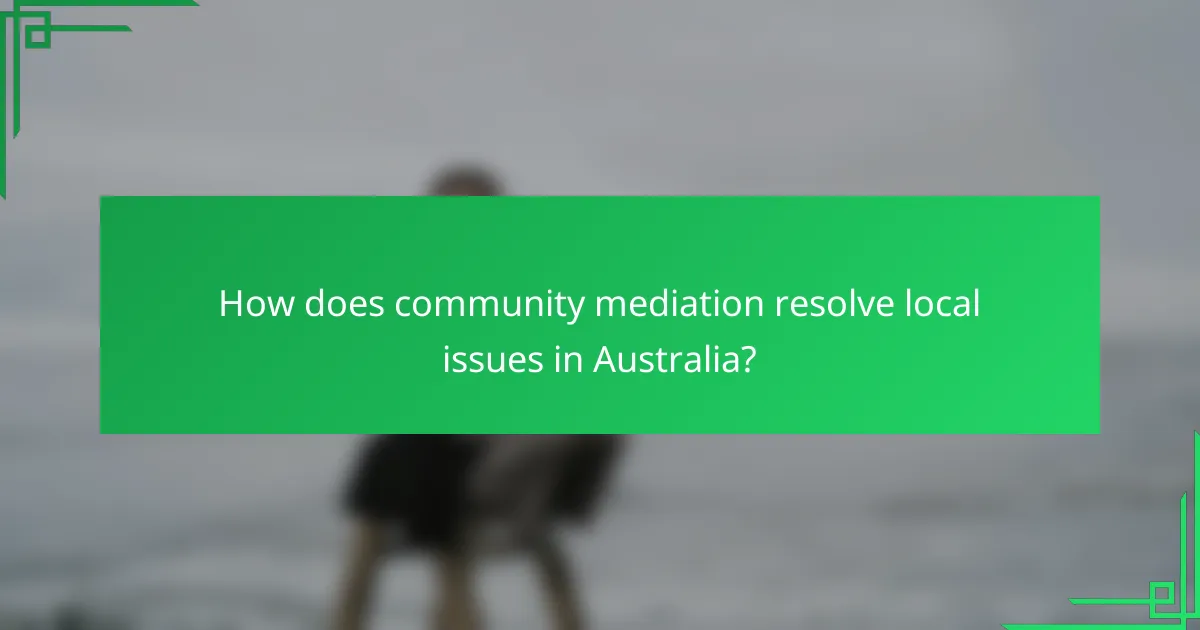
How does community mediation resolve local issues in Australia?
Community mediation in Australia effectively addresses local issues by facilitating open dialogue between conflicting parties, leading to mutually beneficial resolutions. This process not only resolves disputes but also fosters stronger community ties and enhances collaborative problem-solving.
Facilitated dialogue
Facilitated dialogue is a core component of community mediation, where a neutral third party guides discussions between conflicting individuals or groups. This structured approach encourages participants to express their concerns and perspectives in a safe environment, promoting understanding and empathy.
In practice, facilitators may use techniques such as active listening and summarization to ensure all voices are heard. This method can significantly reduce tensions and pave the way for constructive solutions that reflect the needs of all parties involved.
Conflict resolution strategies
Community mediation employs various conflict resolution strategies tailored to the specific issues at hand. Common approaches include interest-based negotiation, where parties identify their underlying interests rather than focusing solely on positions, and brainstorming potential solutions collaboratively.
These strategies often lead to creative outcomes that might not have been considered in a more adversarial setting. For example, local councils in Australia may utilize these techniques to resolve disputes over community resources, ensuring that all stakeholders feel valued and heard.
Community involvement
Community involvement is crucial in the mediation process, as it encourages broader participation and investment in the outcomes. Engaging local residents in mediation initiatives not only helps in identifying issues but also fosters a sense of ownership over the solutions.
Programs that promote community involvement often include workshops, public forums, and outreach efforts to educate residents about mediation benefits. By actively participating, community members can contribute to a more harmonious environment and reduce the likelihood of future conflicts.
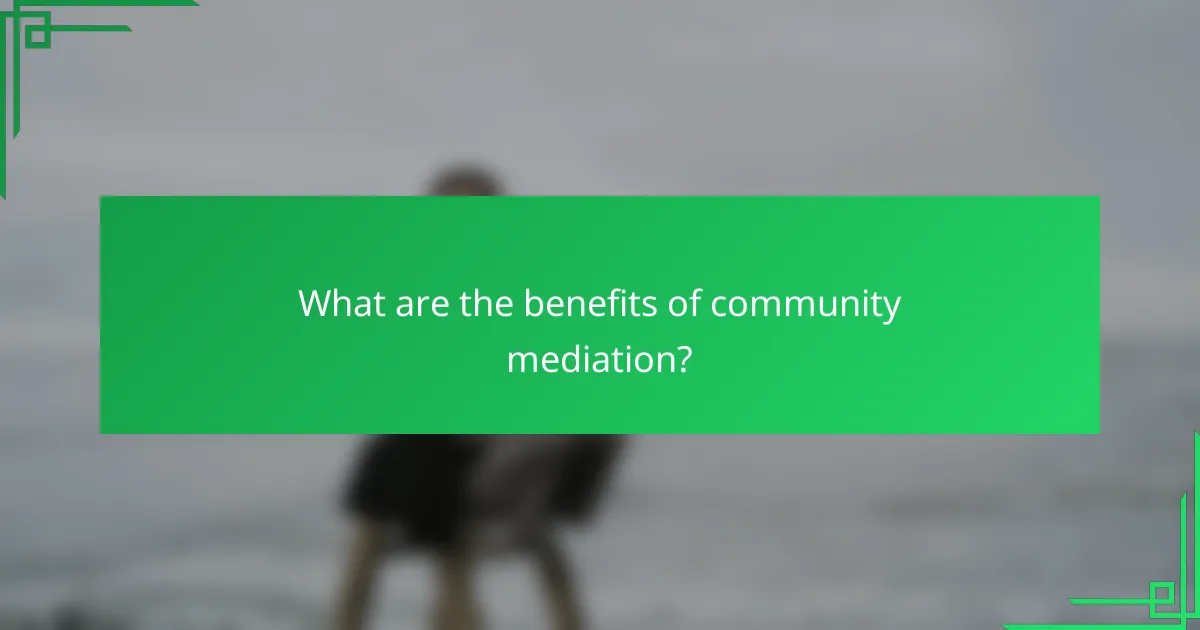
What are the benefits of community mediation?
Community mediation offers numerous advantages, including effective resolution of local disputes, enhanced community engagement, and a cost-efficient alternative to traditional legal processes. By fostering dialogue and understanding, it helps maintain harmony within neighborhoods.
Cost-effective solutions
Community mediation is often significantly cheaper than litigation, making it an attractive option for resolving disputes. Costs can range from minimal fees for mediation sessions to free services offered by local organizations, allowing participants to save on legal fees and court costs.
Additionally, mediation typically requires fewer resources and less time than court proceedings, which can span months or even years. This efficiency translates into lower overall expenses for individuals and communities alike.
Strengthened community ties
Engaging in community mediation fosters stronger relationships among residents by promoting open communication and collaboration. Participants often find common ground, which helps to build trust and understanding within the community.
As neighbors work together to resolve conflicts, they develop a sense of ownership and responsibility towards their community, leading to a more cohesive and supportive environment.
Reduced legal expenses
By choosing community mediation, individuals can avoid the high costs associated with legal battles. Traditional legal processes can incur significant expenses, including attorney fees, court costs, and potential damages.
Mediation, on the other hand, allows parties to reach agreements without the burden of extensive legal fees, making it a financially viable option for many. This reduction in legal expenses enables individuals to allocate resources to other important areas of their lives or community projects.

What is the process of community mediation?
Community mediation is a structured process that helps resolve local disputes through facilitated dialogue. It involves neutral mediators who guide the parties to reach a mutually acceptable agreement, fostering community engagement and reducing conflict costs.
Initial consultation
The initial consultation is the first step in community mediation, where the mediator meets with the parties involved to understand the issues at hand. This meeting typically lasts about an hour and allows each party to express their concerns and desired outcomes.
During this consultation, the mediator explains the mediation process, sets ground rules, and assesses whether mediation is suitable for the situation. It’s crucial for participants to be open and honest, as this sets the tone for future discussions.
Mediation sessions
Mediation sessions are where the actual dialogue takes place, usually involving multiple meetings. Each session can last from one to three hours, depending on the complexity of the issues and the willingness of the parties to engage.
In these sessions, the mediator facilitates communication, helping each party to articulate their perspectives and explore potential solutions. The goal is to create a safe environment for discussion, allowing for the identification of common interests and areas for compromise.
Agreement formulation
Once the parties reach a consensus, the next step is to formulate a written agreement. This document outlines the terms of the resolution and is designed to be clear and actionable, ensuring that both parties understand their commitments.
It’s essential that the agreement is realistic and enforceable, as this helps prevent future disputes. The mediator may assist in drafting this agreement, ensuring it reflects the interests of both parties and is in compliance with local regulations.
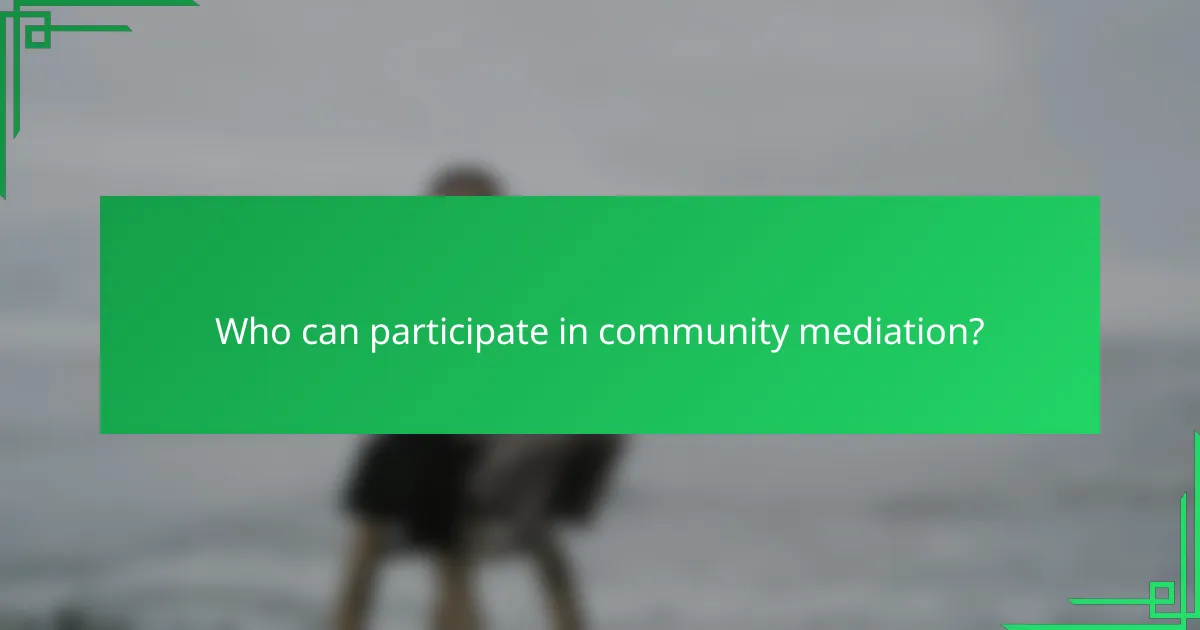
Who can participate in community mediation?
Community mediation is open to various stakeholders, including local residents, community organizations, and government representatives. Each group plays a vital role in addressing local issues and fostering engagement within the community.
Local residents
Local residents are often the primary participants in community mediation, as they are directly affected by neighborhood issues. They bring personal experiences and insights that are crucial for understanding the context of disputes.
Residents should consider attending mediation sessions prepared to share their perspectives and listen to others. This collaborative approach can lead to more effective resolutions that reflect the community’s needs.
Community organizations
Community organizations, such as non-profits and advocacy groups, can participate in mediation to represent the interests of specific populations or issues. Their involvement helps ensure that diverse voices are heard and considered in the resolution process.
These organizations often have resources and expertise that can facilitate discussions and provide support to residents. They should aim to foster a collaborative environment and encourage open dialogue among all parties involved.
Government representatives
Government representatives, including local officials and agency staff, play a crucial role in community mediation by providing insights into regulations and policies that may impact resolutions. Their presence can lend authority to the mediation process and help ensure compliance with local laws.
These representatives should approach mediation with a mindset of collaboration, focusing on finding solutions that benefit the community as a whole. It is essential for them to listen actively to residents and organizations to understand their concerns fully.
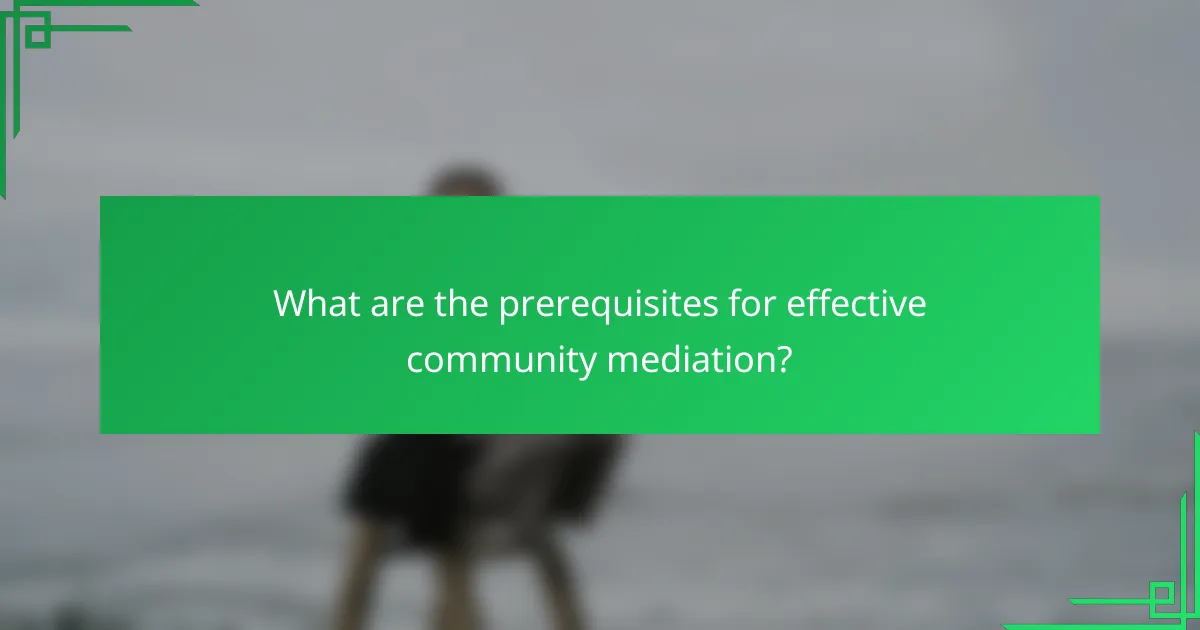
What are the prerequisites for effective community mediation?
Effective community mediation requires a collaborative environment where all parties are willing to participate, neutral mediators facilitate discussions, and clear communication channels are established. These elements ensure that conflicts can be addressed constructively and lead to satisfactory resolutions for everyone involved.
Willingness to engage
Willingness to engage is crucial for successful community mediation. All parties must be open to discussing their issues and seeking resolution, which fosters a cooperative atmosphere. When individuals are committed to the process, they are more likely to find common ground and work towards mutually beneficial solutions.
Encouraging engagement can involve setting clear expectations and emphasizing the benefits of mediation, such as reduced conflict and improved community relationships. It’s important to create a safe space where participants feel comfortable expressing their concerns without fear of judgment.
Neutral mediators
Neutral mediators play a vital role in community mediation by facilitating discussions without taking sides. Their impartiality helps build trust among participants and ensures that all voices are heard fairly. Effective mediators are trained to manage emotions and guide conversations toward productive outcomes.
Choosing the right mediator is essential; they should have experience in conflict resolution and a deep understanding of community dynamics. Local organizations often provide access to trained mediators who can assist in navigating complex issues while maintaining neutrality.
Clear communication channels
Establishing clear communication channels is fundamental for effective community mediation. This involves creating structured ways for participants to share their perspectives and concerns openly. Regular meetings, written agreements, and feedback loops can enhance understanding and reduce misunderstandings.
Utilizing technology, such as community forums or messaging platforms, can also facilitate ongoing dialogue. It’s important to ensure that all participants have access to these channels and feel empowered to use them, as this promotes transparency and encourages active participation in the mediation process.

How does community mediation compare to traditional legal processes?
Community mediation offers a more collaborative and flexible approach to resolving disputes compared to traditional legal processes. While legal avenues can be lengthy and formal, mediation focuses on dialogue and mutual agreement, often leading to quicker resolutions.
Time efficiency
Community mediation typically resolves disputes much faster than traditional legal processes. While court cases can take months or even years to conclude, mediation sessions can often be scheduled within weeks, allowing parties to reach agreements promptly.
This time efficiency is achieved through streamlined procedures and the absence of lengthy legal formalities. For example, a mediation session can often be completed in a few hours, whereas a court trial may require multiple hearings over several months.
Lower costs
Community mediation is generally more cost-effective than pursuing legal action. Legal fees, court costs, and other expenses can accumulate quickly in traditional legal processes, often reaching thousands of dollars.
In contrast, mediation services are often offered at a fraction of the cost, sometimes even on a sliding scale based on income. Many community mediation programs charge nominal fees or operate on a donation basis, making them accessible to a wider range of individuals.
Informal environment
The informal setting of community mediation fosters open communication and reduces the adversarial nature of disputes. Unlike courtrooms, which can feel intimidating and rigid, mediation takes place in a more relaxed atmosphere, encouraging participants to express their concerns freely.
This informality can lead to more creative solutions that satisfy all parties involved. For instance, mediators often facilitate discussions that allow for personal stories and emotional expressions, which can be crucial in reaching a mutually agreeable outcome.
